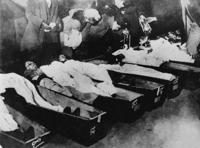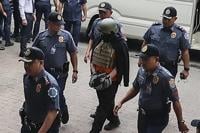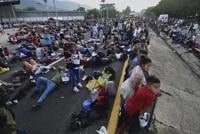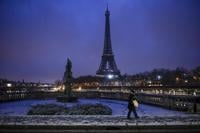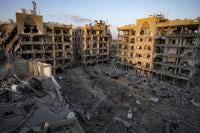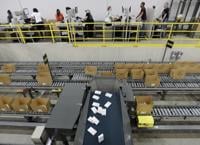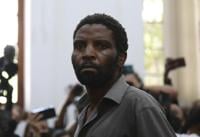NEW YORK (AP) — If people really looked for history at the New York City building where the Triangle Shirtwaist factory once existed, they could find it. There are plaques pointing out that it was the site of a horrific fire in 1911 that became a catalyst in the American labor movement's fight for workplace safety protections.
But for some, a few words on a wall aren't nearly enough to honor .
So after years of effort, the Remember the Triangle Fire Coalition on Wednesday is dedicating a new memorial that has no chance of being overlooked.
A giant steel ribbon with the names of those who died in the disaster, predominantly women and girls, has been installed running horizontally from one corner of the building. Underneath it, a reflective panel shows the stenciled names as well as quotes from people who were there, describing the mayhem.
In the coming weeks, a vertical steel column will be added to the corner to span almost the entire height of the building, a reference to how high up the victims were stuck.
It’s the story of desperate immigrant women, mostly Jewish and Italian, who were because there were no workplace safety rules that said it couldn’t be. Some jumped to their deaths from the windows to avoid the flames.
“What they will see is a memorial that tries to build into the object itself the history of the fire, a history of working women, a history of Italians and Jews, a history of tragedy, but then also a history of change,” said Mary Anne Trasciatti, a Hofstra University professor and president of the coalition.
The victims were close to the end of their working day on March 25, 1911, when a fire started on the eighth floor of the clothing factory, which took up the top floors of a building now owned by New York University.
Frantic workers tried to get out as the flames spread to the ninth and 10th floors, some scrambling to get into an elevator, others heading for the roof. But others who tried to get past a door to escape found it locked, trapping them inside. At a trial of the factory’s owners afterward, some said the door had been kept locked on purpose, over theft concerns.
Firefighters responded quickly. But their ladders were too short to get to the topmost floors.
Horrified witnesses in the crowd watched as workers leapt from the windows. Among those bystanders was the late Frances Perkins, already an anti-poverty advocate trying to change workplace conditions, and who became even more dedicated after what she saw that day.
“It really started her in her push for ‘we have to treat workers better,’” said Ileen DeVault, professor of labor history at Cornell University.
Some of her words recollecting the day are part of the memorial, running along the reflective panel. “Every one of them was killed, everybody who jumped was killed.”
Perkins would be part of a state commission that put a series of safety rules in place in New York that were emulated elsewhere, and later became an integral part of President Franklin Roosevelt’s cabinet as his secretary of labor. She pushed for policies like minimum wage, workers compensation, and old age pensions.
One of the names on the memorial will be that of Rosie Weiner, who died in the blaze, but whose sister and fellow factory worker, Katie Weiner, made it out alive.
Later, Weiner would recount how she grabbed an elevator cable to make her escape. Today, her great-niece, Suzanne Pred Bass, is on the board of the Remember the Triangle Fire Coalition.
Growing up, Bass knew her great-aunt had lived through the fire, but it wasn’t until years later that she heard about Rosie.
Bass’ mother remembered accompanying her mother as a small child to the pier where the victims' bodies were taken after the fire.
“She never forgot that, she was 4 years old and I can only imagine how how scary and awful,” Bass said.
Memorial designers Richard Joon Yoo and Uri Wegman wanted to find a way for modern-day people to connect with the fire and its legacy, they said. The public was invited a few years ago to contribute pieces of fabric that were joined together in a 300-foot (91-meter) “Collective Ribbon." That ribbon’s design was then etched onto the memorial steel that rises up toward the top of the building.
It was important to make that connection between past and present because issues of labor, workplace protections, and how workers are treated are still far from settled in the country and the world, Yoo and Wegman said.
“Everything that it talks about with women workers, immigration, labor, it’s these touch points that just keep on flaring up over and over and over again,” Yoo said, pointing out that industrial disasters, at garment factories and elsewhere, still happen around the globe.
The two came up with the design for the memorial about a decade ago. It is coming to fruition, with a capital budget of about $3 million, during a year of labor activism in some U.S. industries, with strikes by auto workers, hospital staff, film and television writers and screen actors.
It just shows that the Triangle Shirtwaist fire still has lessons to impart, Bass said.
“We forget a tragedy like this at our own peril,” she said. “We have the same issues, immigrant issues, safe working condition issues, abuse of women in the workplace issues. It’s not like any of these issues are all fixed."


